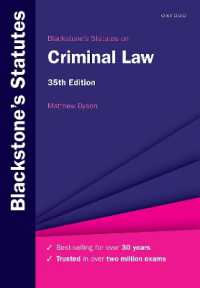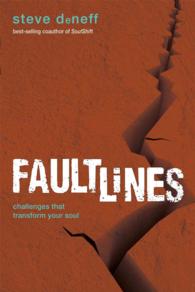- ホーム
- > 洋書
- > 英文書
- > History / World
Full Description
Communities in Transition brings together scholars from different countries and backgrounds united by a common interest in the transition between the Neolithic and the Early Bronze Age in the lands around the Aegean. Neolithic community was transformed, in some places incrementally and in others rapidly, during the 5th and 4th millennia BC into one that we would commonly associate with the Bronze Age. Many different names have been assigned to this period: Final Neolithic, Chalcolithic, Eneolithic, Late Neolithic [I]-II, Copper Age which, to some extent, reflects the diversity of archaeological evidence from varied geographical regions. During this long heterogeneous period developments occurred that led to significant changes in material culture, the use of space, the adoption of metallurgical practices, establishment of far-reaching interaction and exchange networks, and increased social complexity. The 5th to 4th millennium BC transition is one of inclusions, entanglements, connectivity, and exchange of ideas, raw materials, finished products and, quite possibly, worldviews and belief systems. Most of the papers presented here are multifaceted and complex in that they do not deal with only one topic or narrowly focus on a single line of reasoning or dataset. Arranged geographically they explore a series of key themes: Chronology, cultural affinities, and synchronization in material culture; changing social structure and economy; inter- and intra-site space use and settlement patterns, caves and include both site reports and regional studies.
Contents
I. PREFACE
Acknowledgements
INTRODUCTION
II. INTRODUCTORY AND OVERARCHING STUDIES
Inventing the Final Neolithic
C. Renfrew
Transformation and changes at the end of the Neolithic
K. Kotsakis
Village nucleation and centralization in the Later Neolithic of Southeastern Europe:
a long-term, comparative approach
W.A. Parkinson, W.P. Ridge & A. Gyucha
Greece in the fifth and fourth millennia B.C.: searching for the 'missing' fourth millennium. A new approach.
I. Aslanis
The shadowy "Proto-Early Bronze Age" in the Aegean
J.E. Coleman & Y. Facorellis
Casting doubts on metallurgy and the transition to social complexity: the evidence
from the Aegean.
M. Mina
III. THE BALKANS
Settlement pattern changes during the central Balkan Copper Age
A. Kapuran, A. Bulatović & D. Milanović
Modeling the black box. Bulgaria in the 4th millennium BC
I. Merkyte
Possible approaches to tracing the fate of the population of the Varna, Kodjadermen-
Gumelniţa-Karanovo VI and Krivodol-Sălcuţa Cultures.
P. Georgieva
Kozareva Mogila, a settlement and a necropolis from the west Black Sea region.
P. Georgieva, M. Popova & V. Danov
Chalcolithic settlement at Varhari: one production and trade center in the Eastern
Rhodope Mountains.
K. Boyadzhiev & Y. Boyadzhiev
The Latest Late Chalcolithic settlement at tell Yunatsite
V. Matsanova & T. Mishina
Late Chalcolithic cult tables from tell Yunatsite, Bulgaria
S. Terzijska-Ignatova
Rethinking the absolute chronology of South-Eastern Balkans in the later half of the
5th and in the 4th millennium BC.
M. Kufel & Ł.Pospieszny
Graphite and carbon: relative and absolute chronology between the Aegean and the
Black Sea in the 5th millennium BC.
A. Reingruber
The lithic technology on the territory between Lower Danube and Marmara region -
6 th - 5th millenium BC
I. Gatsov & P. Nedelcheva
Synchronization of the Albanian and north Aegean Late Neolithic periods. New data
from the lakeside dwelling of Kallamas (Albania)
C. Oberweiler, G. Touchais & P. Lera
IV. NORTH GREECE AND THESSALY
The chronological and social dimensions of the Late Neolithic I-II and the Late
Neolithic-Early Bronze Age transitions in a long-lived settlement in northern
Greece (Dikili Tash, Kavala district).
Z. Tsirtsoni, P. Darcque, H. Koukouli-Chryssanthaki, D. Malamidou & R. Treui.
Transformations of space in the Late Neolithic settlements of northern
Greece.
M. Pappa
Visviki Magoula, Thessaly. Reconsidering cultural change from the Arapi to the Dimini phase.
E. Alram-Stern
The role of Theopetra cave in Thessaly Greece, at the end of the Neolithic. Habitual or symbolic use?
N. Kyparissi-Apostolika
Beyond transition: tracing eventfulness behind the Middle Neolithic-Late Neolithic ceramic divide.
S. Katsarou-Tzeveleki
The beast with many heads: assembling bodies and changing history in the fifth millennium BC.
S. Nanoglou
V. WEST, CENTRAL AND SOUTH GREECE
Demographic Transitions from the Earlier Neolithic Stages until the first Early BronzeAge Settlements in the Plains and Hill-Country of Boeotia, Greece.
J. Bintliff & K. Sarri
Late Neolithic traditions. New evidence from the cave of Sarakenos, Kopais.
A. Sampson and V. Mastrogiannopoulou
Lion's Cave, Hymettus Mountain, Attica: figurines, structures and material culture associations.
L. Karali, F. Mavridis & D. Lambropoulos
The Later Neolithic use of the cave Oinoe IV, at Marathon (Attica, Greece): preliminary report.
A. Mari
The end of the Neolithic in eastern Attica: new data from Kontra Gliate (Kiapha Thiti) and Thorikos Mine 3.
M. Nazou
The Kastria/Pangali group and the beginning of the Chalcolithic in Southern Greece.
S. Dietz & P. Bangsgaard
Reading social changes in the Late Neolithic/Final Neolithic transition at Drakaina Cave, Kephalonia, W. Greece
G. Stratouli & O. Metaxas
Caves and the landscape of Late Neolithic - Early Helladic I Greece: comparing
excavation and survey data from the Peloponnese..
D. J. Pullen
New evidence for the beginning of habitation at Aigeira / Achaia (Greece).
W. Gauss
Stones, pots... and now ornaments: revisiting the MN/LN and the LN/FN transitions
at Franchthi.
C. Perlès
The EH I cemetery in Kalyvia in ancient Elis.
J. Rambach
Long-distance exchange of melian obsidian: diachronic changes at the cave site of
Alepotrypa, Greece.
D. Riebe
VI. AEGEAN ISLANDS, CRETE AND CYPRUS
Aghios Ioannis, Thasos: the economy of a small coastal site dated to the second half of the fourth millenium BC.
S. Papadopoulos, O. Palli, S. Vakirtzi & E. Psathi
Neolithic to Chalcolithic transition in the Island of Gökçeada (Imbros).
B. Erdoğu
Land Management in the Final Neolithic/Early Bronze Age? Some tantalizing indications from Southern Euboea.
Ž. Tankosić
The Later Neolithic cultures of the Aegean archipelago with special reference to the Cyclades. Connecting strategies of space use.
F. Mavridis
Strofilas, Andros. New perspectives on the Neolithic Aegean.
C. A. Televantou
The LN and FN phases on Kos and the Alasarna settlement pattern.
M. Georgiadis
CRETE
Settlement patterns and social organization in Crete during the Final Neolithic and the beginning of the Bronze Age (ca. 3700-3000 BC).
K. Nowicki
The introduction of pressure blade technologies into Crete in the late 4th millennium BC: where, how and to what end?
T. Carter
The earliest phase of the FN at Phaistos in a wider Cretan context: new perspectives.
S. Di Tonto
The FN-EM I transition in south-central Crete: new data from Phaistos.
S. Todaro
Gavdos or living on the southernmost Aegean island in the Neolithic cultural horizons.
K. Kopaka & E. Theou
CYPRUS
The entry of Cyprus into the circum-Aegean world and the growth of regionalism on the island.
E. Peltenburg
Rethinking the 'Cypriot paradox': socio-economic change in Late Neolithic and Chalcolithic Cyprus.
I. Voskos
VII. WEST ANATOLIA.
The Middle Chalcolithic Period in the Troad: a new look from Gülpınar.
T. Takaoğlu & A. Özdemir
On the marble conical rhyta: new evidence from Yeşiltepe in West Anatolian hinterland.
T. Takaoğlu & A.O. Bamyacı
The Chalcolithic period at Yeşilova Höyük.
Z. Derin & T. Caymaz
What follows the Late Neolithic occupation in Central-Western Anatolia ? A view from Ulucak.
Ö. Çevik
The Chalcolithic of coastal Western Anatolia: a view from Liman Tepe, Izmir.
R. Tuncel & V. Şahoğlu
Interaction as a stimulus? Çukuriçi Höyük and the transition from the Late
Chalcolithic period to the Early Bronze Age in Western Anatolia.
B. Horejs & Ch. Schwall
The prehistoric culture in Çine-Tepecik and its contribution to the archaeology of the region.
S. Günel
Cave habitations in Chalcolithic Lycia. The case of Tavabasi Cave at Tlos.
T. Korkut, G. Isin & T. Takaoğlu
At the crossroads. Changing Chalcolithic settlement patterns in Phrygia, Eskisehir.
A. Umut Turkcan
VIII. BIBLIOGRAPHY








